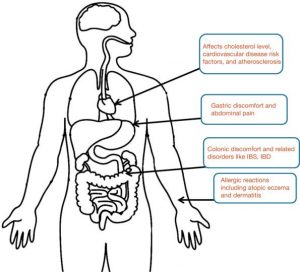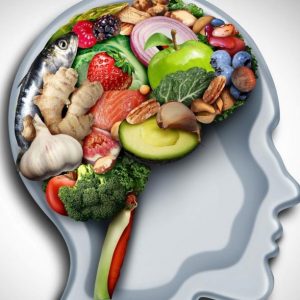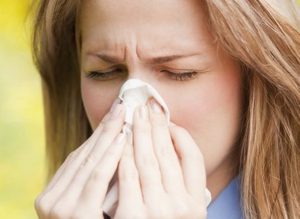There are more bacteria in your body than your own cells- you have roughly 40 trillion bacterial cells and only 30 trillion human ones. (That means you are more bacteria than human!)
Altogether, these microbes may weigh as much as 1–2 kg, which is roughly the weight of your brain. And together they function as an extra organ in your body.

Most of these bacteria are in your digestive system and are referred to as your gut microbiome. Your gut contains up to 1,000 species of bacteria, so you have a whole ecosystem inside you. Each of them plays a different role in your body, and most are extremely important for your health, particularly your digestive system, immune system, heart health, mental state, food intolerances, and hormone balance, The right probiotics can help restore the balance to your internal ecosystem and help resolve the related health problems.
(For more about the importance of gut bacteria, please read
Ok, so gut bacteria are important. What probiotic should I take?
That depends on many factors, including your symptoms. Because there are so many different bacteria that are involved in different roles, there are over 18 different probiotics that we commonly prescribe, including specific strains or combinations for
So you can see that over-the-counter probiotics don’t usually do a lot, as your gut ecosystem is very complex and they are not specific for each individual.
If you would like to see if you need an individually prescribed, practitioner level probiotic to help sort out your health issue, please book in to see one of our expert naturopaths. Or even better, book in for a free Comprehensive Assessment, where we can check what is going on in your body, what is causing any problems, and the best way to sort them out. (Terms and conditions- the Assessment is a completely free service, with no obligations whatsoever.) Be well!
Could something as simple as food make a difference to your mood and mental state? And if so, how does this work and which foods are best?
A lot of it depends on the connections between your brain and digestive tract. Due to this close connection, diet and emotions can sometimes go hand in hand. This has even led the digestive tract to sometimes be referred to as “the second brain”.
In your gastrointestinal tract, there are billions of bacteria — and these bacteria can influence neurotransmitter production. In this context, neurotransmitters are important chemical substances that carrying messages from your gut to your brain.

Whenever you eat healthily, you’re actually promoting the growth of so-called “good” bacteria in your gut. This will then have a positive effect on the production of neurotransmitters. On the other hand, if your day-to-day diet is laden with high-sugar junk foods, you could experience inflammation within your gut. This inflammation will make it more difficult for your body to adequately produce mood-boosting neurotransmitters.
Sugar is probably the most common culprit behind inflammation in the gut, Even worse, sugar can help to feed any “bad” bacteria that are currently in your gastrointestinal tract. Sugar is tricky because it can actually result in a temporary spike in certain “feel good” neurotransmitters, such as dopamine. This can be deceptive, leading individuals to believe that consuming sugary foods will boost their mood, making them come back for more.
When neurotransmitter production spikes in this way, it’ll be followed by a crash and this crash will have an extremely negative effect on your mood. This can lead to a sort of vicious cycle, with your neurotransmitter production spiking and plummeting if you regularly consume sugary foods.
If you’re hoping to experience fewer fluctuations in mood, then it may be time to reduce the amount of sugar you’re consuming on a day-to-day basis. A diet based on healthy foods can actually promote an overall happier mindset — it could also make it easier to stay focused.
When food is better for the health of your gut, it’s often also going to be better for your mood and mental health. Here’s a shortlist of some gut-friendly foods, able to enhance the production of mood-lifting neurotransmitters.
1. Dark Chocolate
That’s right, dark chocolate is more than just a delicious treat — it is packed full of other mood-lifting compounds and has less sugar than other treats.
When you consume dark chocolate, you can expect a release of “feel good” compounds, such as theobromine and N-acylethanolamine.
In addition, dark chocolate is full of healthy flavonoids, which can help with the flow of blood to your brain, boost overall brain health, and reduce inflammation. All of these effects can help with mood regulation.
Try to avoid milk chocolate, which is higher in sugar and fat, and isn’t going to have the same benefits as consuming dark chocolate.
2. Fatty Fish
Fatty fish is one of the best dietary sources of omega-3s and is an easy (and tasty) one to incorporate into your diet. For instance, both albacore tuna and salmon are packed full of two particular omega-3s — eicosapentaenoic acid (EPA) and docosahexaenoic acid (DHA). Both EPA and DHA have been linked to lower levels of depression, making them some of the best dietary mood boosters out there.
Plus, omega-3s can help support the fluidity of brain cell membranes.
3. Fermented Foods
Fermented food comes in a wide variety of forms, so it’s harder to get bored with them. Examples of some popular fermented food items are
Thanks to the fermentation process, these foods are loaded with health-supporting probiotics. Basically, during fermentation, live bacteria are given a chance to thrive, and these bacteria will convert the sugars into healthier acids and alcohols.
Worth noting is the fact that not all fermented foods are high in probiotics. For example, foods like beer and some breads have very little probiotics due to the cooking and filtering processes when they are made.
4. Nuts and Seeds
Nuts and seeds are chock-full of healthy fats, plant-based proteins, and fibre. Fibre is able to slow down the digestion of other carbs, which means that sugar is more gradually released into your bloodstream. So, less of a spike and a crash, allowing your energy levels to stay stable.
Nuts also provide you with tryptophan. Tryptophan is an amino acid and is responsible for serotonin production. A variety of nuts and seeds (including cashews, almonds, walnuts, pumpkin seeds, sunflower seeds, and sesame) are high in this particular mood-lifting amino acid.
Other nuts, including pine nuts, Brazil nuts, and almonds, are good sources of selenium and zinc. Both of these minerals are quite important to healthy brain function, and a deficiency of them has been linked to higher rates of depression.
While some foods can supply you with a boost in mood, others can lead to a drop, including
Those are just a few examples, although the general rule remains: foods that are high in sugar, as well as foods that are highly processed, are probably going to be worse for your mood. Additionally, alcohol is considered to be a depressant, so long-term it can also have a negative effect on your mental state.
The specific food items you are eating aren’t all that can affect your mood. Your food-related habits and tendencies can also play a role. If you’re looking to boost your mood, consider building a better relationship with food and adopting the following habits:
Eat Regularly
When you create a habit of not eating for long stretches of time, followed by eating large amounts of food, you’re probably experiencing frequent blood sugar drops. Whenever your blood sugar plummets, you’re more likely to feel irritable, tired, or even depressed. If you’re eating regularly and opting for foods that slowly release energy (whole-grain bread, nuts, and seeds, oats, etc.), your levels are more likely to stay stable, and you can avoid drops and spikes in blood sugar.
Getting Your Five a Day
As well as eating fruits and vegetables, it is important to have the correct amount of them. Having at least five servings of fruits and vegetables a day is ideal.
Further, try to eat a wide variety of different fruits and vegetables, in order to get a bigger array of nutrients. Focus on consuming fruits and veggies of many colours, as this is an indicator of the nutrients they may contain.
Meal Planning and Mindful Eating:
Try preparing a week’s worth of chopped veggies and soaked/cooked legumes or beans ahead of time, to make it easier to whip up a homemade meal that could be as tempting as a takeaway.
If meal prepping isn’t for you, stock up on frozen or canned veggies- just look for low sodium products to avoid too much salt. You can also try microwavable grains, such as quinoa, brown rice, or whole-grain couscous.
If you are looking for lower carb options, try swapping your usual grains and carbohydrates with vegetable-based options instead. Look for cauliflower products such as cauliflower pizza crusts, cauliflower “rice” and cauliflower “mashed potatoes”.
No matter what changes you decide to implement, just remember, the basic rules of nutrition still apply. Focus on making a habit of staying hydrated, eating regular meals, and being mindful of how much caffeine and alcohol you consume.
You may not be able to make all of these changes at once and that is fine. Even just small adjustments like being mindful of what you’re eating, and appreciating the good feeling a nutritious meal gives you afterward, can make a big difference over time.
If you would like to eat better, improve your health, or you have a health problem or chronic disease you want to sort out, we offer a free Comprehensive Assessment, to establish what is going on in your body, what is causing the problem, and the best way to sort it out. (Terms and conditions- the Assessment is a completely free service, with no obligations whatsoever.) Be well!

Many people with digestive issues will try avoiding gluten, and will often feel much better as a result. However, could this be causing them other problems instead?
Iodine deficiency is one of the three most common nutritional deficiencies, and the World health Organisation has said that Australia’s population has higher levels of iodine deficiency than normal. To combat this, in 2009 it became compulsory for iodine to be added to bread in Australia.
Iodine is very important for proper thyroid function, Your thyroid controls the rate of activity of the cells of your body, so if it is underactive, everything slows down, including your energy and metabolism. Hormones produced by the thyroid are important for brain function and development, growth and healing. So if your iodine levels are low, you can develop
Iodine deficiency can seriously affect children, especially at the foetal, newborn or infant stages, as their brains need thyroid hormone for proper development. A lack of iodine may cause a miscarriage or premature birth, and children with low iodine are also more likely to have attention deficit hyperactivity disorder (ADHD).
A world-renowned endocrinologist and expert in the field, Professor Creswell Eastman said that “Iodine deficiency has re-emerged in Australia in the last 10 years and it is now a significant public health problem. We know that 50 per cent of Australian women are iodine deficient so they are putting their pregnancy and foetus at great risk.”
Prof Eastman said mums with the worst cases of iodine deficiency could knock 15 points off their child’s IQ.
Unlike nutrients such as iron, calcium or vitamins, iodine does not occur naturally in specific foods. Instead, it is the level of iodine in the soil determines the level of iodine in the food, and so iodine deficiency occurs when the amount in the soil is low.
If you are trying to avoid gluten you may have a low iodine intake (especially if you avoid iodised salt as well). Please note that we are not advocating that if you are sensitive to gluten you should be eating bread! However, with any restrictive diet it is important to ensure you are getting enough of the right nutrients. If you would like to check if a lack of iodine or any other nutrient is affecting your health, you may like to book in a session with one of our naturopaths. Or even better, book in for a free Comprehensive Assessment, to find out what is going on in your body, what is causing any problems, and the best way to sort them out.

When you have hayfever, your immune system sees a harmless airborne substance as potentially harmful. Your immune system then produces antibodies to this substance. The next time you come in contact with it, these antibodies signal your immune system to release chemicals such as histamine into your bloodstream, which cause the symptoms of hayfever.
So the most common treatments for hayfever are antihistamine medications.
What is Histamine?
Histamine is a chemical produced by your body to
(As a neurotransmitter, histamine communicates important messages from your body to your brain.)
However, histamine’s main role is to cause an immediate inflammatory response. It serves as a ‘red flag’ to your immune system, notifying it of any potential attackers.
Histamine causes your blood vessels to swell, or dilate, so that your white blood cells can quickly find and attack the infection or problem. The build-up of histamine may give you headaches and leave you feeling flushed, itchy and miserable. This is a part of the body’s natural immune response, but if your body doesn’t break the histamine down properly, you could develop what is termed a histamine intolerance.
Because it travels throughout your bloodstream, histamine can affect your gut, lungs, skin, brain, and the entire cardiovascular system, contributing to a wide range of problems in the body. (Due to the many areas affected and the diverse symptoms, it can often be difficult to pinpoint and diagnose the cause of the problem in these cases.)
The body controls histamine levels by producing an enzyme called diamine oxidase (DAO). But if too much histamine or not enough DAO is produced, allergies will occur.
Foods can have a major influence on histamine levels, by containing histamine themselves, by causing the body to release histamine, or by blocking the release of DAO by the body.
Histamine-Rich Foods
Histamine-Releasing Foods
DAO-Blocking Foods
However, there are a number of foods that can help to reduce your histamine levels. Please note that freshness is the key with these foods when you have a histamine intolerance.
Low-Histamine Foods:
Raising your DAO levels is also important in combatting hayfever.
Although histamine blockers seem like they would help prevent histamine intolerance, these medications can actually deplete DAO levels in your body, so will make the hayfever worse in the long run.
Basic Level
Try to remove as many of the ‘Foods to Avoid’ and increase the ‘Foods to Have’ as much as you can, starting 1-3 months before the hayfever season. But most importantly, find the root cause for the histamine intolerance. If you are on a medication that is causing the intolerance, check with your doctor if you can be weaned off this medication.
If you have a histamine intolerance, you may not have to try to avoid these foods forever. It can be a short-term solution until your histamine or DAO levels return to their optimal ranges. (Depending on your unique make-up, you may find that you tolerate some foods better than others.)
Advanced Treatments
We have covered how different foods can affect your histamine levels, but why do some people have hayfever and others don’t? Almost any over-reaction by the immune system (such as allergies, food intolerances, or auto-immune disorders) has its origin in the digestive system. The two most common causes are
These probiotic strains are not normally available over the counter; instead they must be prescribed by a qualified therapist trained in this area, such as a registered naturopath.
When your immune system spots these large molecules, it decides that they are too big to be digested food, so it must be a foreign invader into the body, such as a virus or bacteria, and it attacks them. If your immune system over-reacts every time you eat something, eventually it may start reacting to other proteins it becomes exposed to, such as those in pollens, dust, etc., and then allergies such as hayfever develop.
(There are other causes for hayfever, but they are less common.)
If you are suffering from hayfever and would like to treat the real causes of the problem, we suggest booking in for a Comprehensive Assessment at our clinic. We can then have an in-depth look at what is happening in your body, what is causing the problem, and what can be done to sort it out. (Terms and conditions- the Assessment is a completely free service, with no obligations whatsoever.) Most people find their assessment very helpful, interesting and informative.
The ‘microbiome’ is a popular topic at the moment for anyone interested in their health and well being, but what exactly it is? You may have heard about the good bacteria living in your digestive system, and might have thought about taking a probiotic to support them. Your body contains an internal community of a massive 38 trillion microbes (not just bacteria), and this community is referred to as your commensal microbiome, or microbiome for short. The guts of it is, when your microbiome is healthy it helps make you healthier, and when it is unhealthy it makes you less healthy.
When healthy and balanced, your microbiome has a range of wide-reaching effects on your health, such as creating important vitamins you need, helping to control and boost your immune system, assisting with waste elimination through healthy bowel functions, and even affecting your mood and mental state.1
However, diet, lifestyle and other factors can reduce both the number and the diversity of these organisms in our gut. This can create an environment where pathogenic (disease causing) organisms have the opportunity to establish themselves and ‘take over’ parts of your digestive system. This state of imbalance is termed ‘dysbiosis’, and often results in a broad range of health issues, including digestive problems, nutrient deficiencies, or a compromised immune system (which can lead to food intolerances, allergies, or frequent infections).
The following are the most common diet and lifestyle factors that can have a negative impact on the health of your microbiome.
Avoiding or addressing the diet and lifestyle factors mentioned above is important for improving the health and diversity of your microbiome. However, perhaps the most important thing you can do to help, is to consume a diet rich in plant based fibres, which will provide a great food source for the beneficial organisms to flourish.
Figure 1: Foods that Feed Your Microbiome
If ‘bad’ (pathogenic) bacteria and other organisms have established in your gut and are creating dysbiosis, there are specific natural products to correct this. For example, antimicrobial herbal medicines can be used, including pomegranate (Punica granatum),5 nigella (Nigella sativa),6 and myrrh (Commiphora myrrha).7,8 These herbs work to eliminate unwanted organisms in the gut.
Then, to regenerate and rebuild the health and diversity of your microbiome, specific probiotic strains can be used. Some of these include
So even though diet, lifestyle or antibiotic use can upset your microbiome, there are plenty of natural medicines and diet options to restore it’s health as well, and improve the wellbeing of your whole body.
If you have any digestive or immune problems, or want to improve your mood or general health and well being, we offer a free Comprehensive Assessment, to establish what is going on in your body, what is causing the problem, and the best way to sort it out. (Terms and conditions- the Assessment is a completely free service, with no obligations whatsoever.) Please call us on 3376 6911 if you have any questions at all, or ring or book online if you would like to make an appointment.
References
The above table and much of the information in this article is from a Metagenics blog titled ‘5 Ways You Might Upset Your Gut Microbiome and What to Do About It’.
1. D’Argenio S. The role of the gut microbiome in the healthy adult status. Clinica Chimica Acta. 2015;451(Part A):97-102.
2. Buschman H, Bright D. Big Data from World’s Largest Citizen Science Microbiome Project Serves Food for Thought. [Internet]. San Diego (CA): UC San Diego School of Medicine. 2018 [cited 2018 July 05]. Available from: https://health.ucsd.edu/news/releases/Pages/2018-05-15-big-data-from-worlds-largest-citizen-science-microbiome-project-serves-food-for-thought.aspx
3. Engen PA, Green SJ, Voiqt RM, Forsyth CB, Keshavarzian A. The Gastrointestinal Microbiome: Alcohol Effects on the Composition of Intestinal Microbiota. Alcohol Res. 2015;37(2):223-36.
4. Guilliams TG. The role of stress and the HPA axis in chronic disease management. Point Institute, Stevens point (WI). 2015;80.
5. Abdel-Haffez E, Ahmed A, Abdellatif M, Kamal A, Toni N. The efficacy of pomegranate (Punica granatum) peel extract on experimentally infected rats with blastocystis spp. J Infect Dis Preve Med. 2016;4(1):1-6.
6. Salem EM, Yar T, Bamosa AO, Al-Quorain A, Yasawy MI, Alsulaiman RM, et al. Comparative study of Nigella sativa and triple therapy in eradication of Helicobacter pylori in patients with non-ulcer dyspepsia. Saudi J Gastroenterol. 2010 Jul;16(3):207.
7. Fathy FM. Effect of mirazid (Commiphora molmol) on experimental giardiasis. J Egypt Soc Parasitol. 2011 Apr;41(1):155-77.
8. Basyoni MM, El-Sabaa AA. Therapeutic potential of myrrh and ivermectin against experimental Trichinella spiralis infection in mice. Korean J Parasitol. 2013 Jun;51(3):297-304. doi: 10.3347/kjp.2013.51.3.297.
9. Moré M, Swidsinski A. Saccharomyces boulardii CNCM 1-745 supports regeneration of the intestinal microbiota after diarrheic dysbiosis – a review. Clinical and Experimental Gastroenterology. 2015;8:237-55.
10. Anderson JM, Barrangou R, Hachem MA, Lahtinen SJ, Goh YJ, Svensson B, et al. Transcriptional analysis of prebiotic uptake and catabolism by Lactobacillus acidophilus NCFM. PLos ONE. 2012;7(9):e44409.
11. Mäkeläinen H, Saarinen M, Stowell J, Rautonen N, Ouwehand AC. Xylo-oligosaccharides and lactitol promote the growth of Bifidobacterium lactis and Lactobacillus species in pure cultures. Benef Microbes. 2010 Jun;1(2):139-48.

(Note: whilst it is likely that green tea and green tea extracts provide effective prevention against a broad range of viruses, there is no evidence to date that they are effective against the COVID-19 virus.)
We recommend gargling with freshly made green tea, and then swallowing the tea, every day.

Fortunately, these effects can be offset using the superhero nutrient sulforaphane, which stimulates toxin elimination. It also reduces the fall-out from toxic exposure by strengthening antioxidant defences.
The War Against Toxins
The battle between antioxidants and toxins is much like a war between good and evil. Toxins create molecules known as free radicals, which cause damage to our cells: a process known as oxidative stress. Conversely, antioxidants are substances that can neutralise free radicals, thereby protecting our cells and tissues from damage.
Our body also neutralises and eliminates toxic substances via detoxification, with the liver primarily responsible for eliminating the toxins we are exposed to. Whilst the liver is an efficient organ, it can benefit greatly from detoxification support to prevent it from becoming overburdened by constant toxin exposure. This is where sulforaphane plays a key role, enhancing the body’s detoxification processes and reducing damage caused by free radical exposure.
Sulforaphane Saves the Day
Sulforaphane is an ingredient made by the body from nutrients found within cruciferous vegetables, such as broccoli, cabbage and kale. Sulforaphane increases antioxidant protection by stimulating the antioxidant defence system within the body that protects against the effects of oxidative stress.
Additionally, sulforaphane enhances detoxification activity in the body by inducing enzymes involved in metabolism of harmful toxins by the liver, promoting their elimination.
The Elusive Hero
Providing your body with sulforaphane is not as simple as adding a few extra spoonfuls of broccoli to your dinner plate; you need to provide your body with the right ingredients to make it. The main ingredient is glucoraphanin, found primarily in broccoli seeds, however you also need myrosinase, found in high concentration in broccoli sprouts, to ‘activate’ it (Figure 1).
Figure 1: Sulforaphane is made from glucoraphanin, with a little help from myrosinase.
Although broccoli does contain both glucoraphanin and myrosinase, you would need to consume almost two cups of raw broccoli each day to attain enough for a beneficial amount of sulforaphane. For those who prefer cooked broccoli, the heating process destroys myrosinase, so while cooked broccoli can give you glucoraphanin, there is not enough myrosinase to convert it into sulforaphane in the body.
Additionally, vitamin C is needed to turn on myrosinase, making it a vital ingredient for sulforaphane production. Therefore, whilst this hero ingredient is formidable in the face of its toxin foe, its strength can remain elusive given the wrong circumstances. A carefully crafted supplement derived from seed and sprout, containing glucoraphanin, myrosinase and vitamin C, provides the building blocks for sulforaphane production, ensuring your antioxidant superhero steps out of the shadows and shines!
Time for a Spring Clean
If you are feeling sluggish, tired, and less than your best, a detoxification can help you to make a clean start to Spring with renewed health and vitality. We can provide you a safe and effective professional detoxification program, tailored to your individual needs.
To find out your current toxicity level, you can complete our online Comprehensive Toxicity Questionnaire.
If you are interested in finding out if toxins may be causing problems in your body, we offer a free Comprehensive Assessment at our clinic. It will also allow us to identify what is causing any health issues you may have, and the best way to resolve them. Most people quite enjoy their Assessment, and find it very helpful and informative. There is no cost or obligation whatsoever for an Assessment, and you can give us a call or book online.
(Acknowledgement- much of the content of this article is from a blog by Metagenics, a highly regarded research and practitioner-only supplement supplier. https://blog.metagenics.com.au/overpowering-toxins-with-sulforaphane-not-all-heroes-wear-capes/ )

Here is a small sample of different foods and a few of their effects.
Celery
Garlic
Pears
Ginger
Dandelion Tea
Pineapple
As you can see from this small sample, there is far more to food than just a bunch of nutrients! As Hippocrates, the founder of modern medicine is believed to have said, “Let food be thy medicine, and let medicine be thy food.”
If you have any questions about a particular food and how it affects the body, please let us know.

So shouldn’t everyone drink green tea?
Everyone’s body works a little differently to everyone else’s. Some people naturally have more energy, have better eyesight, or better circulation, while others may react to certain foods, have dryer skin, or catch colds more easily. No two bodies ever work exactly the same.
One of the effects of green tea is to block the enzyme that breaks down histamine in our bodies (diamine oxidase, or DAO). Histamine triggers inflammation in the body, and typically causes allergy symptoms such as sneezing, redness, itching, etc. (Anti-histamine medications are often used to decrease these symptoms.) It also causes the reactions when you have a food allergy.
If you don’t produce enough DAO and are unable to break down your histamine properly, you could develop a histamine intolerance. Some common reactions associated with this intolerance include
In more severe cases of histamine intolerance, you may experience:
So if you have high histamine levels, it is best to avoid foods that contain a lot of histamine, foods that cause the body to release histamine, or foods that block DAO.
Everything we eat or drink has an effect on the body in some way. Because every body functions a little differently, what is good and beneficial to one person’s health might be no good for someone else. For example, pears help to moisten the lungs so they can be helpful if you have a dry cough, but excessive use of pears during pregnancy may increase the risk of a miscarriage in some people.
If you are interested in finding out what foods are ideal for you, and for addressing any health problems you may have, we have two excellent naturopaths at our clinic. We also offer a free Comprehensive Assessment, to see what is going on in your body, what is causing any problems, and the best way to sort them out. (Terms and conditions- the Assessment is a completely free service, with no obligations whatsoever.) If you would like to have one done, please book soon while this offer is still available.

If so, you may be deficient in iron.
Its main use is to transport oxygen in your body, but it supports many other body and mental functions as well.
Some of the common causes of iron deficiency include
In 2000, scientists discovered a compound called hepcidin, and deemed it the “Master Regulator” of iron metabolism.1 Essentially, hepcidin controls whether iron can get into and out of cells. This affects a few key processes related to iron metabolism:
Typically, hepcidin levels are increased when there is a high level of circulating iron. This reduces absorption of iron from the diet, reduces the amount of recycled iron released into the system, and converts more iron into the storage form, ferritin. All of this helps to protect the body from iron overload.
Inflammation can also cause hepcidin production to increase.2 The increase in response to inflammation helps our bodies defend against invading bacteria, viruses, or other pathogens. Foreign invaders need iron to survive and thrive, just as we do. Therefore, the body responds by increasing hepcidin levels, causing much of the available iron to be converted to ferritin and put into storage. The lack of iron in the blood suppresses the ability of these invaders to grow and multiply.
Ferritin levels are usually a good measure of your overall iron status, but in the presence of inflammation, they may act as an immune response marker instead of an indicator of your iron stores.
However, inflammation in the body can come from other sources apart from invaders. These include strenuous exercise, a niggling injury, contraceptive pills, digestive problems, allergies or food intolerances, inflammatory bowel disease, excess weight, autoimmune diseases, poor diet, stress, and lack of sleep.
Your blood test will often include your levels of
The balance of these readings is often helpful in determining what is causing your low iron.
In many types of iron deficiency the transferrin and TIBC may be high. Remember that the TIBC and transferrin are not measuring the amount of iron in the blood but the ability of the blood to carry iron. When the body lacks iron, it increases the amount of transferrin to gather as much of it as it can.
(Women using the contraceptive pill will often have high transferrin levels as well.)
On the other hand, those with chronic inflammation usually have low transferrin (or TIBC).
Here is a summary of the typical test results for the common types of iron deficiency.
| Iron deficiency caused by | Serum iron | Transferrin or TIBC | Transferrin saturation |
Ferritin | |
| Low intake, low absorption, blood loss | Low | High | Low | Low | |
| Chronic inflammation | Low | Low | Low | Normal / high | |
This chart is only a very general guide. For example, after strenuous exercise, your demand for oxygen will have increased, so your levels of transferrin will be higher short term. But if you over-exercise over a long period, the chronic inflammation may cause your transferrin levels to become low. And over time, if your body is not absorbing iron as fast as it is losing it, your ferritin levels will also become low.
So interpreting blood tests correctly requires careful evaluation, and a knowledge of the person’s diet and lifestyle.
Obviously, the most important thing is to identify and address what is causing the problem. Having said that, some of the more common considerations are
Don’t take these if you don’t need to.
The best iron supplements are easily absorbed by the body, and contain extra vitamin C to increase the absorption rate. They contain a bio-available form of iron, and are very unlikely to cause any of the side effects associated with some of the others.
If your iron levels seem to be low all the time, just check with your doctor first to make sure there isn’t anything serious happening. Then we can check what is going on in your body and recommend the correct diet, supplements or treatment for you, to help you get your energy and spark back again. We even offer a free Comprehensive Assessment, to perform a detailed check of how your body is working and the best way to sort it out. (Terms and conditions- the Assessment is a free service, with no obligations whatsoever.) So if you would like to enjoy better energy and better health, please give us a call.
References:

Valued at $120, your Assessment will help to uncover:
All this will be fully explained to you, and you can ask as many questions as you like. That way we can be sure to give you all of the right information, understanding and advice you need. Terms and conditions: This is a free, no obligation offer.